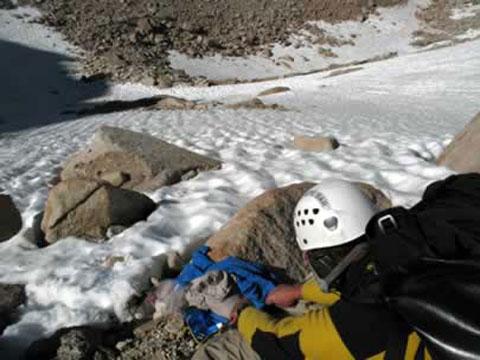The combination of highly skilled rescue personnel and modern technology made three recent rescues at Yosemite National Park amazingly quick and efficient operations. Not so many years ago, such situations would have required many hours or even days and a small army of rescuers.
Rangers and rescuers in the park’s Mather District were involved in three significant rescue operations during the first week of July. According to a park report:
• On July 1, Park dispatch received a cell phone call reporting that a climber had fallen on the Southwest Face route on Cathedral Peak. The climber, a 29-year-old woman, sustained multiple traumatic injuries and was in and out of consciousness. She’d fallen 30 to 40 feet to a large ledge; her partner was about 90 feet below.
A rescue mission was immediately launched by a helitack crew in the park’s contract helicopter. Hasty and climbing teams also headed toward the scene of the accident. Aerial recon confirmed that another climber was with the woman on a large fourth class ledge three pitches from the base of the peak. [translation: this was steep and difficult terrain!]
A park medic was inserted onto the ledge via short haul with a litter and medical and packaging gear. The climber was packaged and short hauled off the ledge with the medic to the catch team in Tuolumne Meadows. The patient was then put inside the helicopter, flown to Crane Flat helibase, and immediately transferred to a PMI medical helicopter with flight nurses. The elapsed time from the launching of the park helicopter to the transfer of the woman to the PMI helicopter was an astounding 40 minutes.
A second technical operation was conducted by the Tuolumne Meadows SAR team to help lower the patient’s partner and the climbers who assisted her. Ranger Scott Jacobs was the Incident Commander (IC).
• On July 4, Park dispatch received a 911 call concerning an injured hiker at the 12,500-foot elevation of Mount Dana. She reportedly suffered a ground level fall while hiking through talus; she suffered a contusion to her head and was complaining of headache, nausea and dizziness. Yosemite’s contract helicopter and helitack crew picked up two rescuers from Yosemite Valley and flew to the scene.
The pilot was able to land the helicopter about a third of a mile from the injured hiker. A park medic determined that she could walk to the helicopter. She was flown to Tuolumne Meadows and transferred to an ambulance, then transferred again to Mono County paramedics and taken to the Mammoth Lakes Hospital. Ranger Jason Ramsdell was the IC
• On July 6, Dispatch received a phone call from Vogelsang High Sierra Camp regarding a 52-year-old hiker who slid approximately 50 feet down a steep snow field into talus on the face of Vogelsang Peak, suffering traumatic injuries to a shoulder, hand, and foot. Yosemite’s contract helicopter, helitack crew and park medic Jack Hoeflich flew to Tuolumne Meadows to pick up a second medic, Jason Ramsdell, then assessed the scene.
The hiker was lying at 11,000 feet between two steep snow fields. The rescue team and Incident Commander agreed the safest and fastest rescue would be via short haul. The two park medics were short hauled to the man’s location on a 250 foot line. The medics provided medical care and packaged him for short haul extraction, and they were flown to a catch team at Vogelsang High Sierra Camp, where the man was placed inside the helicopter.
The helicopter then flew to the Crane Flat helibase, placed in an ambulance, and taken to Yosemite Medical Clinic. Ranger Scott Jacobs was the IC.
In all three incidents, everything came together to allow a quick and efficient rescue: a helicopter capable of operating at that altitude, skilled pilots and rescue personnel, efficient communications and good weather.
If there's a downside to these successful operations, it's that some visitors will take such amazing examples of fast response in remote and difficult terrain for granted, and always expect similar results in every crisis. It remains incumbent upon all of us, especially those who climb or use the backcountry, to be properly prepared and equipped for emergencies, in the event help is delayed.
These rescues are a gratifying example of what can be done under the best of circumstances, and every park user should be grateful for those who make such rescues possible.




Comments
During last year's Yosemite Ranger Reunion, we learned that some members of the famed Yosemite Search and Rescue team are highly trained academics, like MIT physicist and Park ranger John Dill. Ranger Dill is known to have used mathematical probability analyses based on Bayesian statistics to find lost hikers and downed aircraft in difficult terrain.
Last October, a special US Dept. of Interior Distinguished Service Award was presented to John Dill for his outstanding efforts in Yosemite Search and Rescue covering decades of service:
http://www.sfgate.com/cgi-bin/article.cgi?f=/c/a/2008/10/30/MN3Q13ME7B.DTL
Owen Hoffman
Oak Ridge, TN 37830
pkrnger, that is an absolutely fascinating article about one of the most accomplished SAR guys in the parks. Thanks for sharing.
I happened to be at the Volgelsang camp on July 6 and was able to personally witness the expert and brave work performed by the SAR Group in extracting the injured hiker off of the face of Vogelsang Peak. It was a sobering reminder that we are all just one slip or fall away from possible catastrophe. I am thankful for the SAR Teams
Scott Denney
Nashville, Tn.